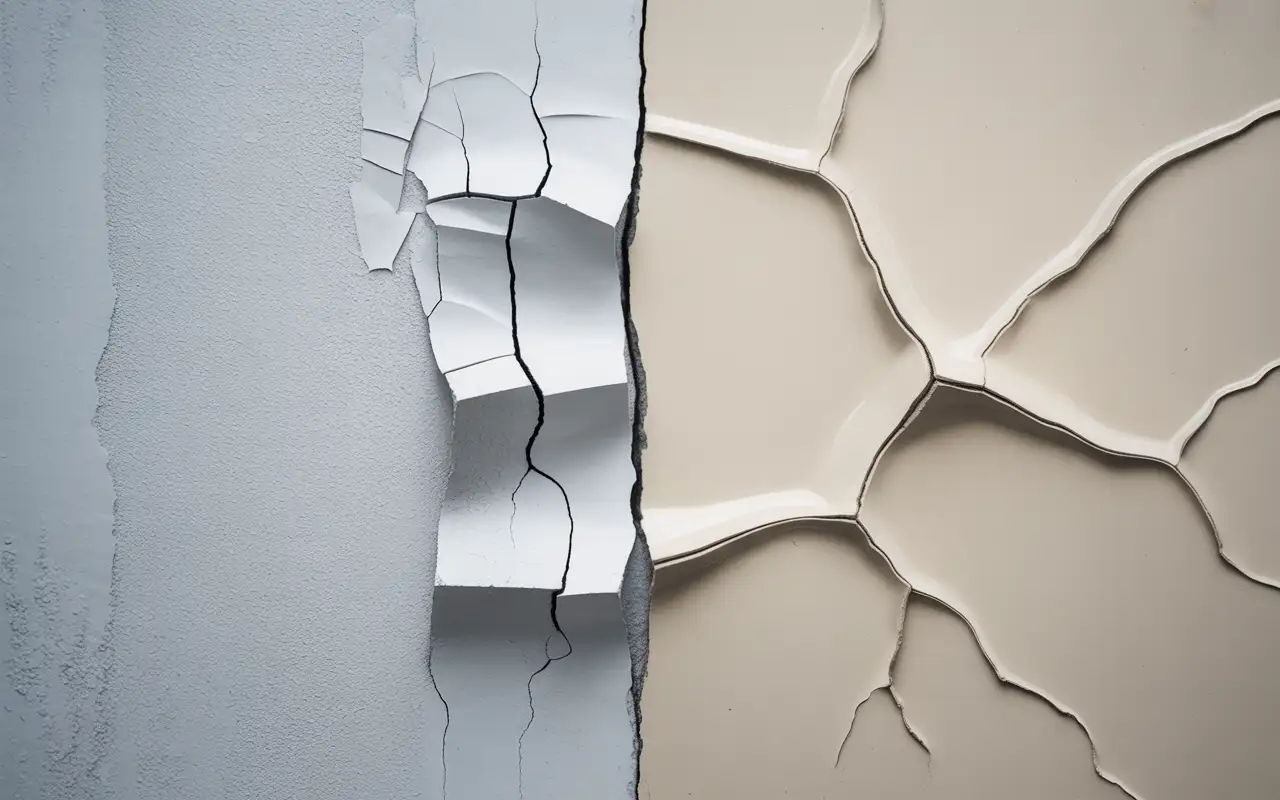You’re standing in front of your freshly painted cabinet wondering if it’s safe to touch. Or maybe you’re staring at a metal door worried about when you can apply that second coat. Here’s what you need to know: oil paint takes 6-8 hours to feel dry but needs 24 hours before recoating. Full cure takes weeks to months depending on thickness and surface type.
This isn’t guesswork. After completing over 200 oil-based painting projects in San Diego, we’ve tracked exact drying times across different surfaces, weather conditions, and paint brands. This guide shares real data to help you plan your project correctly.
Table of Contents
ToggleThe Complicated Nature of Oil Paints
Oil paint and latex paint don’t function the same way. When latex dries, it loses water. When oil paint dries, it goes through a chemical process called oxidation. Oxygen in the air reacts with the oil binder, causing it to harden through polymerisation.
This curing process provides a finish that is stronger and lasts longer than that of water-based finishes. The paint forms molecular chains that stick together, which makes it last a long time and resist scratching. But this chemical process takes a while.
You can think of it as concrete. It feels hard within a few hours, but it takes weeks to get fully strong. The same idea applies to oil paint.
How Long Does Oil Paint Take to Dry?

Here’s the breakdown based on our project tracking:
- Touch Dry: 6-8 hours The surface feels dry and won’t transfer to your finger. The paint underneath is still wet.
- Recoat Time: 24 hours minimum Safe to apply a second coat without lifting the first layer. We always wait overnight.
- Light Use: 3-7 days Doors and cabinets can be used carefully. Avoid heavy contact or cleaning.
- Full Cure: 30-60 days Paint reaches maximum hardness and chemical stability. Now fully resistant to scratches and chemicals.
These times assume 70°F temperature and 50% humidity. Real conditions vary.
Drying Times by Surface Type
We tested oil paint drying on common surfaces. Here’s what we found:
Wood (doors, cabinets, trim):
- Touch dry: 6 hours
- Recoat: 24 hours
- Light use: 5 days
- Full cure: 30 days
Metal (railings, doors, pipes):
- Touch dry: 8 hours
- Recoat: 24-36 hours
- Light use: 7 days
- Full cure: 45 days
Drywall (rare but possible):
- Touch dry: 4-6 hours
- Recoat: 18-24 hours
- Light use: 4 days
- Full cure: 30 days
Concrete/Masonry:
- Touch dry: 10-12 hours
- Recoat: 36-48 hours
- Light use: 10 days
- Full cure: 60 days
Metal takes longer because the paint can’t absorb into the surface. It must cure entirely through air exposure.
Brand Comparison Data
Not all oil paints dry the same. Here’s data from our projects:
- Benjamin Moore Advance (Alkyd): Recoat time: 16 hours. Best for furniture and cabinets. Costs $65-75 per gallon.
- Sherwin-Williams ProClassic (Oil): Recoat time: 24 hours. Great for trim and doors. Costs $55-70 per gallon.
- Behr Premium Plus (Oil): Recoat time: 24 hours. Budget option for DIY. Costs $35-45 per gallon.
The price difference reflects drying speed and durability. Premium paints include better drying agents.
What Factors Affect the Drying Time of Oil Paint?
Five main factors control how fast oil paint dries.
1. Paint Thickness
Thin coats dry faster. Thick applications can take 2-3 times longer.
A standard brush coat (2-3 mils thick) follows normal drying times. Heavy texture or drips can stay soft for days.
We measured this on a cabinet project. Standard coats were touch dry in 7 hours. A thick drip took 28 hours to feel dry.
2. Temperature
Oil paint dries best between 65-85°F. Below 50°F, the drying process slows dramatically. Above 90°F, surface skinning can trap solvents underneath.
San Diego’s mild climate is ideal for oil paint. We rarely face extreme temperatures. But we avoid painting when temps drop below 55°F overnight.
Cold paint also applies poorly and takes longer to level out.
3. Humidity
High humidity is oil paint’s enemy. Moisture in the air interferes with oxidation.
At 30-50% humidity, paint dries normally. At 70%+ humidity, add 50% to all drying times. At 85%+ humidity, avoid oil paint entirely.
We tracked this during San Diego’s rare humid days. Cabinet doors that normally dry in 6 hours took 10 hours at 75% humidity.
4. Ventilation and Air Movement
Good airflow brings fresh oxygen to the paint surface. This speeds up the curing process.
In enclosed spaces, crack a window or run a fan. Don’t point fans directly at wet paint or you’ll get dust contamination.
We tested this in a windowless bathroom. With no airflow, touch drying took 11 hours. With a small fan running, it took 7 hours.
5. Pigment Type
Different colors contain different pigments. These affect drying speed.
- Fast-drying colors: Earth tones (browns, tans), umbers, siennas
- Medium-drying colors: Most common colors, whites, grays
- Slow-drying colors: Reds, blacks, blues with prussian blue
This happens because some pigments act as driers while others slow oxidation. Manufacturers adjust formulas, but differences remain.
What Are the Drying Stages of Oil Paint?
Understanding these stages prevents common mistakes.
Stage 1: Surface Drying (6-12 hours)
The top layer forms a skin. Touch it lightly and it won’t feel wet. But press harder and you’ll feel softness underneath.
Don’t be fooled. The paint isn’t ready for anything yet. This stage just means solvents have evaporated from the surface.
Stage 2: Touch Drying (24-48 hours)
You can touch the paint without leaving fingerprints. It feels dry throughout, not just on top.
This is your recoat window. The paint has oxidized enough to support another layer. But it’s still building strength underneath.
Stage 3: Set Drying (3-7 days)
The paint is hard enough for light use. Cabinets can be opened carefully. Doors can swing. But avoid heavy pressure or cleaning.
This stage is when most homeowners want to use their space. It’s safe with reasonable caution.
Stage 4: Full Cure (30-60 days)
The paint reaches maximum hardness. Chemical reactions are complete. Now it’s fully scratch-resistant and chemical-resistant.
You can clean with normal household cleaners. Heavy use won’t damage the finish. This is what you paid for.
How to Make Oil-Based Paint Dry Faster?
You can speed things up safely. Here are proven methods from our projects.
Use Drying Mediums
Add Japan drier or commercial drying agents to paint. Follow label directions carefully. Too much actually slows drying.
We use this rarely because it can affect durability. But when clients need faster turnaround, 10% Japan drier cuts 2-3 hours off touch dry time.
Popular drying mediums:
- Liquin Original (Winsor & Newton): Reduces drying time by 50%
- Galkyd (Gamblin): Fast drying medium for artists
- Japan Drier: Traditional additive for house paint
Improve Air Circulation
Open windows on opposite sides of the room. This creates cross-ventilation without blasting the paint.
A ceiling fan on low works well. Box fans pointed away from the surface help too.
Control Temperature
Keep the room at 70-75°F. Slightly warm is ideal. Avoid rapid temperature swings.
Space heaters work but keep them 6+ feet from wet paint. Too much direct heat causes problems.
Apply Thin Coats
Two thin coats beat one thick coat every time. Thin applications dry faster and look better.
We brush in one direction, then barely tip off the surface. This leaves just enough paint for coverage.
Choose Fast-Drying Formulas
Modern alkyd paints dry faster than traditional oils. Benjamin Moore Advance recoats in 16 hours. That’s 8 hours faster than standard oil paint.
These cost more upfront but save time on multi-day projects.
Test for Dryness
Don’t guess. Test an inconspicuous spot. Press firmly with your thumb for 5 seconds. If it leaves an impression, it’s not ready.
The fingernail test works too. Gently press your nail edge into the paint. If it dents, wait longer.
Common Mistakes That Slow Drying
- Painting in high humidity: Always check the forecast. Humid days add hours to the drying process.
- Skipping primer: Bare wood soaks up oil and slows drying. Primer seals the surface and promotes faster cure.
- Using old paint: Paint sitting for years loses drying agents. It takes much longer to cure. Buy fresh when possible.
- Over-thinning: Adding too much mineral spirits weakens the paint film and extends the drying process.
- Poor surface prep: Dirty or greasy surfaces prevent proper adhesion and slow oxidation.
Where to Use Oil-Based Paint
Oil paint works best in high-wear areas. The slow drying is worth the durability.
Best applications:
- Kitchen cabinets and bathroom vanities
- Entry doors and door frames
- Window trim and baseboards
- Stair railings and handrails
- Metal surfaces and furniture
The glossy finish and scratch resistance make oil paint ideal for surfaces that get touched frequently.
Avoid oil paint on:
- Interior walls (too slow, unnecessary)
- Ceilings (difficult application, fumes)
- Large flat surfaces (latex works better)
Oil Paint vs Latex Drying Comparison
Latex paint:
- Touch dry: 1 hour
- Recoat: 2-4 hours
- Full cure: 14-30 days
- Cost: $30-50/gallon
Oil paint:
- Touch dry: 6-8 hours
- Recoat: 24 hours
- Full cure: 30-60 days
- Cost: $45-75/gallon
Latex wins on speed. Oil wins on durability. Choose based on your project needs.
For exterior painting services in San Diego, we typically use latex for walls and oil for trim. This balances speed with performance.
What We Do as a Painting Company
At San Diego Custom Painting, our 27 years of experience in the San Diego region means we understand exactly how the coastal environment affects oil paint drying time. We don’t just apply paint; we manage the chemical process to ensure longevity.
When performing interior painting on doors, trim, and cabinets, or providing exterior painting services in San Diego, we follow strict temperature, humidity, and recoat guidelines. Our trustable and experienced process ensures your oil-based finishes achieve the strongest possible full cure. We use only quality materials and proven techniques, protecting your investment against premature wear and tear.
Ready for a durable, professional finish on your home’s high-traffic areas? Contact San Diego Custom Painting today for a free consultation!
Final Thoughts
A lot of people don’t know how important it is for oil paint to cure. If you rush it, you might destroy the finish. If you understand it, you’ll receive professional outcomes.
The 6–8 hours it takes to dry is just the beginning. After a full cure, it really lasts. Keep this in mind when planning your project’s timeline.
Keep in mind the most important things: thin coats, adequate air flow, moderate temperature, and low humidity. You may control drying time by controlling these.
Oil paints made today are much better than they used to be. Alkyd formulations dry quickly without losing the long-lasting quality that makes oil paint worth using.
FAQs About How Long Does Oil Paint Take to Dry?
Can you speed up oil paint drying with a hair dryer?
No. Heat guns and hair dryers cause surface skinning. This traps solvents underneath and weakens the finish. The paint may feel dry but won’t cure properly. Use proper ventilation instead.
How long before oil paint stops smelling?
The odor fades within 24-48 hours with good ventilation. Full smell elimination takes 5-7 days. Low-VOC oil paints smell less but still need ventilation during application.
Can I apply latex paint over oil paint?
Yes, but only after proper prep. Sand the oil paint lightly, clean it thoroughly, and apply bonding primer. The oil paint must be fully cured (30+ days old). Never apply oil over latex without primer.
Does oil paint dry faster in the sun?
Direct sunlight warms the surface too much. This causes uneven drying and potential cracking. Indirect light in a warm room is better than direct sun exposure.
How thick should oil paint be applied?
Aim for 2-3 mils wet thickness. This equals about 1-1.5 mils dry. Use a brush or roller designed for oil paint. Spraying works well for even thin coats.
What temperature is too cold for oil paint?
Below 50°F, oil paint becomes too thick to apply smoothly. Drying time increases dramatically. Below 40°F, don’t paint at all. The paint won’t cure properly.
Can humidity ruin oil paint?
High humidity extends drying time but won’t ruin cured paint. Above 85% humidity during application can cause adhesion problems. Check the forecast before starting.
How do you know when oil paint is fully cured?
After 30 days, the paint should pass the thumbnail test. Press your thumbnail firmly into an inconspicuous area. If it doesn’t leave a mark, the paint is fully cured.
Why is my oil paint still tacky after 24 hours?
Common causes: high humidity, low temperature, thick application, or old paint. Improve ventilation and wait longer. If tackiness persists after 48 hours, the paint may be bad.
What’s the difference between drying and curing?
Drying means solvents have evaporated and the paint feels dry. Curing means chemical oxidation is complete and the paint has reached full hardness. Oil paint dries in hours but cures over weeks.





